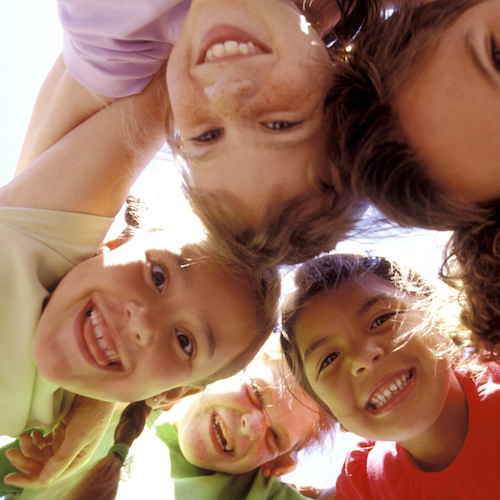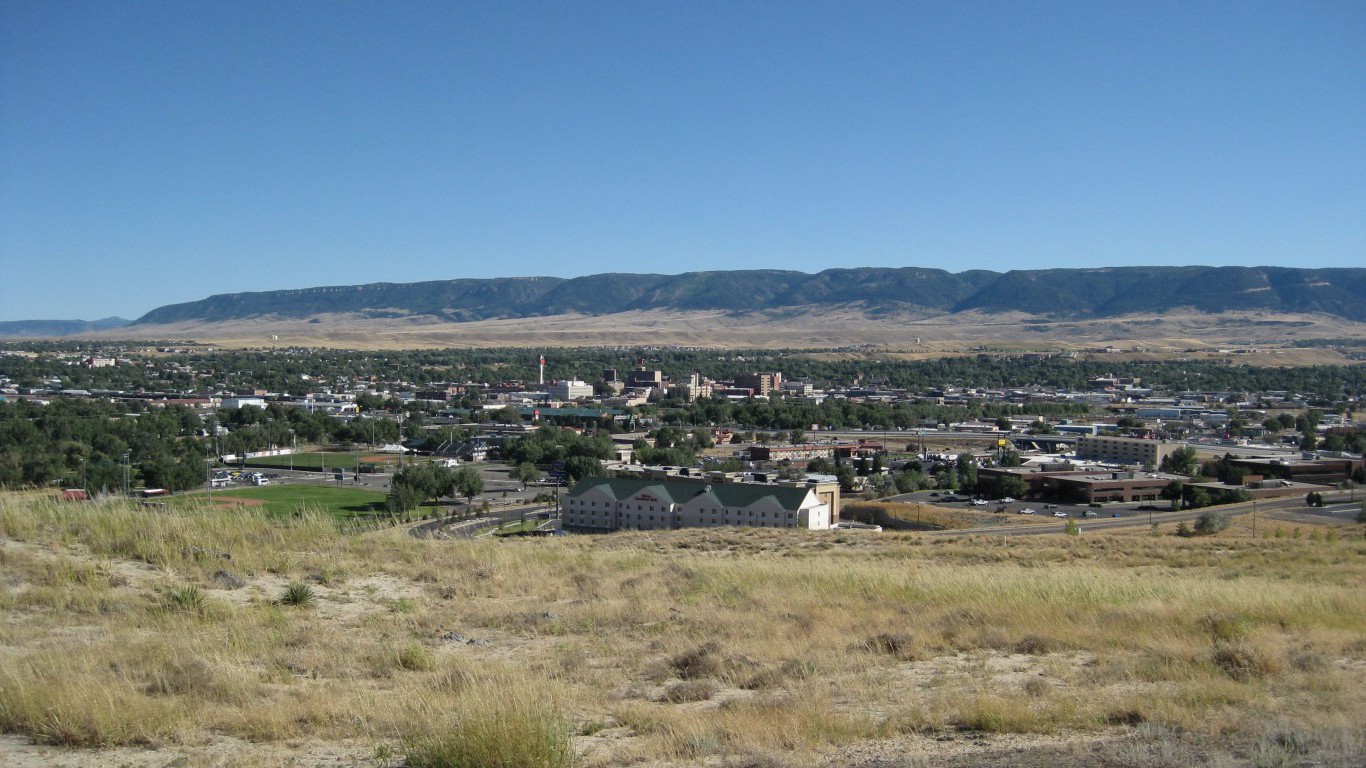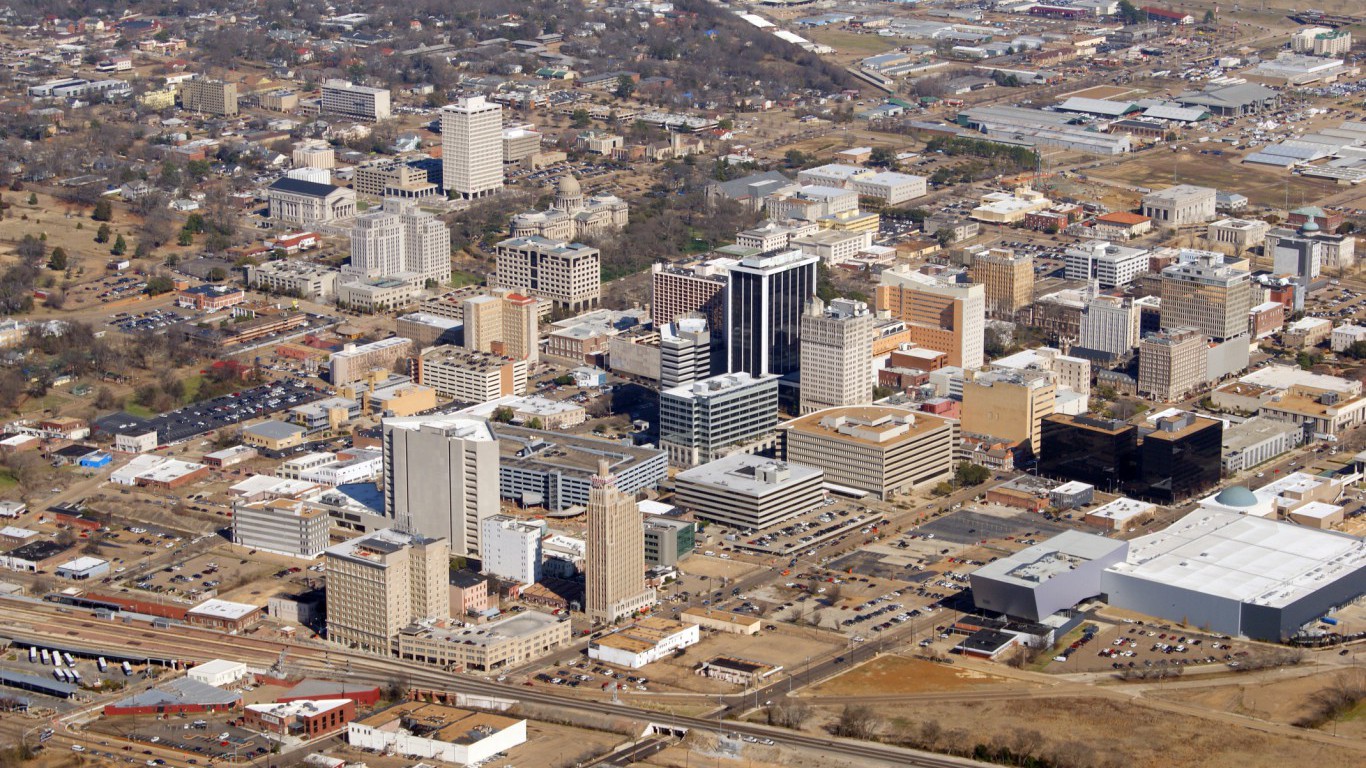Special Report
States Investing the Most and Least in Children

Published:
Last Updated:

Most Americans agree that it is important to provide children with ample opportunities for success, regardless of where they live. To this end, state and local government budgets include provisions for children’s basic education, health care, social services, and other support programs.
Still, children receive widely varying amounts of resources depending largely on their state of residence — this is the conclusion of “Unequal Playing Field? State Differences in Spending on Children in 2013,” a report released Tuesday by nonprofit research organization Urban Institute. 24/7 Wall St. reviewed the 10 states investing the most in their children, and the 10 states investing the least.
[in-text-ad]
States vary in many respects, so the presence of spending differences across the nation is not a major surprise. However, the differences may be much wider than what might be expected. Vermont, which leads the nation with per-child expenditure of $13,430 a year, spends nearly three times as much as last place Utah, which spends just $4,594 per child annually.
Click here to see the states investing the most (and least) in their children.
Generally, more taxes can be collected in states with higher income residents. The median household incomes in eight of the 10 states with the highest per-child expenditures exceed the national median income of $55,775 a year. The opposite is true in states with the lowest per-child expenditures.
In an interview with 24/7 Wall St., Julia Isaac, senior fellow at the Urban Institute, explained how the importance of incomes to state and local tax coffers is in many cases a self-perpetuating cycle. “A state that has more poverty is likely to have lower tax revenue, which makes it tighter for them to spend, and a state that has more families that are doing well has more capacity for raising taxes, which can then support spending.”
The concern is “[in] states that are spending less, it’s harder on the children today and it also may be hard on the state economy in the future,” Isaac said.
Based on current population projections, the already substantial disparity in spending between states is likely to increase. The populations of many of the states with the lowest per-child spending are projected to grow much faster than average, while many of the states with high per-child spending have relatively low projected population growth.
For example, if spending levels do not change In Vermont, where the child population is expected to decline, per-child expenditures will go up. In Arizona, by contrast, where the under 18 population is projected to grow by 16%, spending will have to increase proportionately just to maintain the already relatively low spending levels.
It appears that there is a relationship between the concentration of certain racial heritages in the United States and the level of state and local funding appropriated to children in the state. According to the Urban Institute, approximately 47% of Latino and Hispanic children live in states that spend less than $7,000 per child a year. Half of all Native American children are likely to grow up in a low-spending state. Just 28% of white children grow up in such states.
The federal government guarantees retirement income to seniors regardless of their state of residence. It is if anything more unfair for children to receive different levels of resources based on where their parent lives when they cannot even choose their state of residence. This is one reason Isaac suggests the federal government could do more to equalize spending across states.
To determine the states spending the most and least on children, 24/7 Wall St. reviewed expenditure data from the Urban Institute’s report “Unequal Playing Field? State Differences in Spending on Children in 2013.” The report measures total state and local government spending on K-12 education, Medicaid benefits for people under age 19, the Children’s Health Insurance Program, Maternal and Child Health Block Grants, the Child Care and Development Fund, child support enforcement, child welfare programs, state earned income tax credits, and the Temporary Assistance for Needy Families program. The final expenditure figures are for 2013 and are adjusted for cost of living. For additional analysis, data on the share of the population 19 and under was added from the U.S. Census Bureau’s 2015 American Community Survey. Data on median household income, child poverty rate, child dependency ratio, racial composition, share of foreign-born children, and private school enrollment also came from the ACS and is for 2015. The share of three- and four-year olds enrolled in school came from the National Institute for Early Education Research and is for 2015. Test results for fourth and eighth graders on the National Assessment of Educational Progress are for 2015 and came from Edweek.

10. Maine
> State and local per-child spending: $9,910
> Per-child health spending: $855
> Per-child education spending: $8,831
> Median household income: $51,494
Maine spends nearly $10,000 on education and other social services per child on an annual basis — about $2,000 more than is typical nationwide. Maine is one of five states in New England to rank among the biggest spenders on children’s education, health care, and social services. New England states also tend to have relatively fewer children living in poverty, which, according to some studies, can require as much as twice the financial resources to educate. In Maine, 17.4% of children live below the poverty line, below the 20.7% of all U.S. children.
[in-text-ad]

9. Pennsylvania
> State and local per-child spending: $10,040
> Per-child education spending: $8,747
> Per-child health spending: $1,066
> Median household income: $55,702
Pennsylvania is one of just five states in which total state and local spending on child health care exceeds $1,000 a year. While the state ranks fifth highest in health expenditure per child, it ranks 11th in education spending per student. Greater investment in education has been associated with better educational outcomes, and Pennsylvania has some of the best performing students of any state. According to the NAEP, 41.2% of fourth graders and 39.1% of eighth graders are proficient in reading, each the seventh largest share nationwide.

8. Massachusetts
> State and local per-child spending: $10,734
> Per-child education spending: $9,436
> Per-child health spending: $924
> Median household income: $70,628
Massachusetts spends $10,734 per child per year on a range of services. The vast majority of that spending goes towards education, and though the link between higher educational spending and better outcomes is complex, some 51% of eighth graders in Massachusetts rank as proficient in math, the largest share of any state.
State spending can only go so far in promoting child well-being. Strong family support networks are also important. In Massachusetts, 14.9% of children live in single parent households, well below the 21.0% national share.

7. Rhode Island
> State and local per-child spending: $11,150
> Per-child education spending: $9,107
> Per-child health spending: $1,526
> Median household income: $58,073
Rhode Island spends $11,150 per child annually on a range of services, including education and health care. Most of the states investing the most in their youngest residents are relatively high-income states, and the typical Rhode Island household earns $58,073 a year, about $2,300 more than the typical American household.
Maintaining high spending levels will likely become easier in the coming years. Rhode Island’s child population is projected to decline 6% by 2030, meaning the state can maintain its high per-child spending while cutting $153 million from the budget.
[in-text-ad-2]

6. New Jersey
> State and local per-child spending: $11,590
> Per-child education spending: $10,582
> Per-child health spending: $611
> Median household income: $72,222
Like many of the states investing the most in children, New Jersey has a relatively strong tax base. The typical household in the Garden State earns $72,222 a year, far more than the national annual median income of $55,775.
In every state, education accounts for the majority of government spending on child services. The higher overall spending in New Jersey is partially the result of a high preschool and kindergarten enrollment rate. Some 64.5% of three- and four-year olds in the state are enrolled in such early education programs, the second largest share of any state in the country.

5. Connecticut
> State and local per-child spending: $11,768
> Per-child education spending: $10,640
> Per-child health spending: $669
> Median household income: $71,346
Nearly two-thirds of pre-K age children in Connecticut attend pre-school education programs, the largest share in the country. The high enrollment of three- and four-year olds may help explain the state’s high per child education spending of $10,640 a year, fourth highest of all states. The state’s high overall spending on services directed at children is also likely the result of the residents’ relative affluence. The typical household in Connecticut earns $71,346 a year, fifth most of any state.
[in-text-ad]

4. Wyoming
> State and local per-child spending: $12,080
> Per-child education spending: $11,332
> Per-child health spending: $607
> Median household income: $60,214
While Wyoming spends more on its children than nearly any other state, the share dedicated to social support services is relatively small. State and local governments spend just $141 per child on income support and social services programs a year, far less than the $519 national average. While Wyoming spends relatively little on social support services, its per child annual education expenditure of $11,332 is the highest in the country. According to some Wyoming lawmakers, current education expenditure levels are unsustainable, and the state will need to implement massive spending cuts to avoid a budget shortfall in the coming years.

3. Alaska
> State and local per-child spending: $12,146
> Per-child education spending: $10,605
> Per-child health spending: $1,241
> Median household income: $73,355
Alaska does not fit the typical profile of a high-spending state in several ways. Alaska is one of only a few states on this list not located in the Northeast. Additionally, most states that invest heavily in child services and education report better outcomes. Despite higher spending in Alaska, math and reading proficiency rates among fourth and eighth grade students in the state lag behind the corresponding national averages.
Areas with relatively large Latino and Native American populations tend to spend the least on children. Alaska is the exception to this rule as well, as some 17.6% of the state’s population are either American Indian or Alaska Native, far and away the largest share of any state.

2. New York
> State and local per-child spending: $12,232
> Per-child education spending: $10,751
> Per-child health spending: $856
> Median household income: $60,850
According to the Urban Institute, children living in poverty and children who do not speak English as a first language can cost significantly more to educate. In New York, which has the third highest education spending per child, 22.0% of children live in poverty, higher than the national share of 20.7%. Also, more than 1 in 20 New York state children are foreign born, the third largest share of any state.
Further contributing to the state’s high education expenses is the high average salary for New York’s public school teachers, which at $77,628 a year is the highest of any state.
[in-text-ad-2]

1. Vermont
> State and local per-child spending: $13,430
> Per-child education spending: $11,265
> Per-child health spending: $1,587
> Median household income: $56,990
With more than three working-age adults for every one child younger than 18 years old in Vermont, the state has the lowest child dependency ratio in the country. With taxpayer dollars spread among relatively few children compared to most states, Vermont’s state and local governments spend $13,430 per child on education, health, and social services annually, approximately $5,500 more than the national average. Greater spending on schools, health systems, and social supports has been shown to have positive effects on educational outcomes. In Vermont, students test better than students in nearly any other state. According to the NAEP, 44.7% of fourth graders and 43.8% of eighth graders are proficient in reading, each the third largest share in the country.

10. South Dakota
> State and local per-child spending: $6,593
> Per-child education spending: $5,822
> Per-child health spending: $665
> Median household income: $53,017
With approximately five working-age adults for every two children younger than 18 years old, South Dakota has one of the highest child dependency ratios in the country. With relatively few tax-paying adults per child, state and local governments in South Dakota may be limited in how much they can spend on child-based programs. South Dakota spends just $6,593 per child on education, health, and income support services annually, roughly $1,400 less than the national average. Child-oriented expenditures may soon increase, however, as the state legislature recently passed a $4.6 billion state budget that includes small funding boosts to education and health care.
[in-text-ad]

9. Mississippi DONE
> State and local per-child spending: $6,281
> Per-child education spending: $5,520
> Per-child health spending: $687
> Median household income: $40,593
Providing for the education of children living in poverty can be much more expensive than providing for the education of children living with families with more average incomes, according to the Urban Institute. While the nation-leading 31.3% of Mississippi children living in poverty may suggest a need for higher education expenditure, the state spends an average of just $5,520 per child on education, the 10th least of any state. The low education spending has likely contributed to the students poor performance on standardized tests. Less than 30% of fourth and eighth graders in the state score as proficient on NAEP math or reading exams.

8. Hawaii
> State and local per-child spending: $6,197
> Per-child education spending: $5,357
> Per-child health spending: $459
> Median household income: $73,486
Hawaii spends just $5,357 per child on education annually, roughly $1,600 less than the $6,949 national average. One reason for the state’s low education expenditure may be the extensive private school system on the islands. Private school tuition is relatively inexpensive in Hawaii, likely prompting many residents to enroll outside of the state school system. Approximately 24% of Hawaii children attend private schools, by far the largest share of any state and nearly double the 13% national figure. While Hawaii’s education spending trails nearly every other state, the state spends an average of $381 per child on income support and social services, the eighth most of any state nationwide.

7. Tennessee
> State and local per-child spending: $6,165
> Per-child education spending: $5,413
> Per-child health spending: $611
> Median household income: $47,275
Tennessee is one of several southern states spending less on education and child services than most states. On a per-child basis, state and local spending on child-oriented programs totals only $6,165 annually, less than all but six other states and about $1,800 less than the national average. The low spending is not the only disadvantage that many of the children in the state face. Some 24.1% of children in Tennessee live in poverty, well above the 20.7% national child poverty rate.
Increased investment in youth services will likely only get more difficult in the coming years. The number of children living in Tennessee is projected to grow by 5% by 2030, an increase that will require an additional $514 million in state and local dollars only to maintain current spending levels.
[in-text-ad-2]

6. Nevada
> State and local per-child spending: $6,113
> Per-child education spending: $5,495
> Per-child health spending: $454
> Median household income: $52,431
According to the Urban Institute, nearly half of all Hispanic children in the United States live in low-spending states. In Nevada, the sixth lowest spending state in the country, over 40% of children are Hispanic. Nevada’s low education spending may be tied to its low enrollment in kindergarten and pre-K programs. Just 35.2% of the state’s three- and four-year olds are enrolled in school, the fifth smallest share of any state’s young children.

5. North Carolina
> State and local per-child spending: $5,922
> Per-child education spending: $5,034
> Per-child health spending: $673
> Median household income: $47,830
North Carolina spends an average of $5,922 per child on education, health, and income support services, nearly the lowest of any state. According to a report conducted by the Center on Budget and Policy Priorities, many states cut education spending in the aftermath of the Great Recession, but few as much as North Carolina. Between 2008 and 2014, North Carolina’s per-student spending fell by 15.4%, among the largest declines of any state.
North Carolina’s child population is projected to grow by 13% by 2030, which means that to maintain the same level of funding per student as today, state and local governments will need to spend an additional $1.8 billion.
[in-text-ad]

4. Florida
> State and local per-child spending: $5,857
> Per-child education spending: $5,139
> Per-child health spending: $585
> Median household income: $49,426
Teaching students who are learning English as a second language can be a considerable expense for schools in many states. Florida is likely one such state, as some 5.3% of children in the state are foreign born, the second largest share in the country. Despite additional needs, the state’s per-pupil education spending is nearly the lowest in the country. While low spending does not necessarily lead to poor outcomes, Florida’s schools are not especially high performing. Only 26.1% of eighth graders in the state are proficient in math, and 30.3% are proficient in reading — below the corresponding 32.1% and 32.7% national shares.

3. Arizona
> State and local per-child spending: $4,888
> Per-child education spending: $4,180
> Per-child health spending: $554
> Median household income: $51,492
No state cut education spending in the wake of the recession more than Arizona. According to the CBPP, between 2008 and 2014, the state’s per-pupil expenditure fell by 36.6%, by far the largest decrease in per-student spending in the country. The state’s current per-child education spending of $4,180 is the lowest of any state.
According to the Urban Institute, a disproportionately large share of Hispanic and Latino children live in low-spending states. In Arizona, 43.5% of the child population is Hispanic, the fourth largest share of any state.

2. Idaho
> State and local per-child spending: $4,770
> Per-child education spending: $4,248
> Per-child health spending: $449
> Median household income: $48,275
Idaho has one of the youngest populations in the country. Nearly 30% of residents are 19 or under, the third largest share in the country, and the state’s young population is expected to grow in the coming years. Idaho is one of the few states to average at least two children per family, and by 2030, the state’s population of children is projected to grow by 16%, tied with two other states for the second largest growth rate. Because of this increase, the state’s per-child spending of $4,770 a year, which is already the second lowest in the country, will fall even further to just $4,105, if spending does not go up.
[in-text-ad-2]

1. Utah
> State and local per-child spending: $4,594
> Per-child education spending: $4,251
> Per-child health spending: $282
> Median household income: $62,912
With more than one child for every two adults statewide, Utah’s tax resources are spread far thinner per child than in a majority of the nation. State and local governments spend an average of $4,594 per child on education, health, and income support programs, approximately $3,400 less than the $$7,966 national average.
Increased spending on services for the state’s children will likely only become more difficult in the coming years. The number of children living in the state is projected to grow by 11% by 2030. The influx means the state will need to increase its budget by $468 million simply to maintain current spending levels.
If you’re one of the over 4 Million Americans set to retire this year, you may want to pay attention. Many people have worked their whole lives preparing to retire without ever knowing the answer to the most important question: am I ahead, or behind on my goals?
Don’t make the same mistake. It’s an easy question to answer. A quick conversation with a financial advisor can help you unpack your savings, spending, and goals for your money. With Zoe Financial’s free matching tool, you can connect with trusted financial advisors in minutes.
Why wait? Click here to get started today!
Thank you for reading! Have some feedback for us?
Contact the 24/7 Wall St. editorial team.